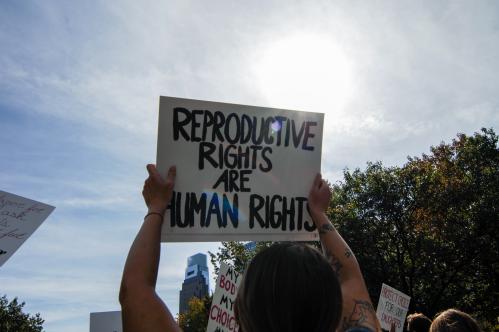The Supreme Court’s draft decision to overturn Roe v. Wade will drastically limit access to abortion in the estimated twenty-three states expected to ban or restrict abortion. Reversing federal protection will result in economic and health consequences for families. Many of the states expected to restrict abortion access also have high unplanned pregnancy rates and low contraceptive use. In a post-Roe world, experts argue that improving access to highly effective contraception is more important than ever.
As Knowles Myers and Welch highlight in their 2021 report, restricting abortion access has consequences for women’s education, labor force participation, occupational prestige, and earnings. Women who choose to get an abortion typically do so because their family is not in a position to support another child. Half of women who had an abortion in 2014 were living below the poverty line, 59 percent already had children, and 55 percent were experiencing a disruptive life event like losing a job, ending a relationship, or falling behind on rent. Most women also receive their abortion early; the overwhelming majority (93 percent) of abortions occur within thirteen weeks.
Restricting abortion has consequences for women’s lives. Evidence from the “Turnaway” study shows that women who intended to have an abortion but were turned away (due to the gestational age threshold in their state) experienced substantial financial distress, including an increase in past-due debt, as compared to women who obtained an abortion. Reducing access to abortion will have widespread consequences for those who feel they are unprepared to add a child to their family, likely resulting in additional disruptive traveling, unintended births, and pregnancy-related mortality.
Nearly half of reproductive-age women live in a state expected to ban or restrict abortion. As Figure 1 shows, thirteen of those states have “trigger” laws in place, which would immediately ban abortions if the Supreme Court overturns its 1973 decision.

Access to family planning services improves the lives of women and their families
Access to family planning, whether it be contraception or abortion, has positive effects on women’s long-term outcomes by allowing them to determine whether, when, and under what circumstances to start or grow their families. The widespread availability of the birth control pill in the second half of the twentieth century allowed researchers to study the impact of contraception on women’s outcomes. Goldin and Katz (2002) find that the availability of the pill was linked to an increase in women’s educational attainment and professional achievement. On the other hand, unintended pregnancies impact women’s life trajectories. According to a survey conducted by the Urban Institute, a majority of women report that an unintended birth would negatively affect their educational attainment, career performance, and mental health.
Access to family planning, whether it be contraception or abortion, has positive effects on women’s long-term outcomes by allowing them to determine whether, when, and under what circumstances to start or grow their families.
Sawhill (2014) notes that children are better off when their parents have adequate incomes, job security, and enough time (and control over their time) to spend on their family. Intentional family planning also improves children’s later-in-life economic outcomes. Sawhill and Venator (2015) find that if all unintended births instead aligned with mothers’ intentional birth timing, children would have better outcomes. For example, children’s college graduation rates would increase by eight percentage points and their lifetime incomes would increase by around $52,000.
Unplanned pregnancies are common, especially in trigger ban states
Despite the benefits of deliberate family planning, nearly half of U.S. pregnancies are unplanned. But families’ contraceptive realities differ greatly across the U.S. Many of the states that plan to restrict access to abortion in the immediate future already have high rates of unplanned pregnancies. In Louisiana, one of the thirteen states that will immediately outlaw abortion, 43 percent of pregnancies are unplanned. By contrast, 31 percent of pregnancies are unplanned in Montana, which recognizes the right to abortion in its state constitution. Figure 2 shows the share of all pregnancies that are unplanned, including those ending in abortion and in birth, by state.

Not all contraceptives are created equal
The evidence is clear: both contraception and abortion access are key components of family planning. While abortion remains a divisive issue, contraceptive use isn’t. Ninety-two percent of Americans see birth control as “morally acceptable.” Almost all sexually active women in the U.S. use at least one contraceptive method in their lifetime. But not all birth control methods are created equal. As Sawhill and Guyot highlight in their 2019 report, long-acting reversible contraceptives (LARCs), like intrauterine devices (IUDs), are the gold standard in contraceptive use. LARCs are becoming more common and often recommended by doctors because of their low failure rates (about 1 percent) and guaranteed contraceptive coverage for an extended period (most for up to five to seven years after placement).[1] LARC usage rates have not yet surpassed the pill, which remains the second most common birth control method after sterilization.
However, the least effective contraceptive options have considerably higher failure rates than the most effective, reversible options. Sawhill and Venator (2014) point out that 38 percent of women will become pregnant within five years while using the birth control pill as their primary form of contraception. After ten years of relying on the pill, 61 percent of women will become pregnant. For less-effective methods, the failure rate is even higher; condoms, if used over ten years, have a cumulative failure rate of 86 percent.
Despite their high failure rate, 13.2 percent of sexually active women ages 15-49 who were not intending to become pregnant reported that they primarily relied on condoms. More than one in ten sexually active women who don’t intend to become pregnant say they don’t use any method of contraception. Like unplanned pregnancy rates, contraceptive use varies across the U.S. Figure 3 shows the share of women in each state who don’t intend to become pregnant who use a less-effective form of birth control or no contraceptive method.

Over half of the women in many trigger ban states are at risk of experiencing an unplanned pregnancy. Nearly 60 percent of Texas women don’t use contraception or rely on less-effective contraception to avoid pregnancy. However, even in states with strong abortion and contraceptive protection — like California and New York — the majority of women also use less-reliable forms of contraception.
Highly effective contraceptives are more important than ever post Roe
Policymakers and experts have long recognized the impact that access to highly effective contraception has on families and state spending. Investing in family planning saves seven dollars per dollar spent. But less than half of states guarantee access and many women live far from a clinic that offers IUDs or implants. For instance, over 175,000 Texas women in need live in a county without a single health center that provides all contraceptive methods. Although LARC access is limited in some counties, almost half of states have legislation in place to allow contraceptives such as the pill, patch, and ring to be prescribed by a pharmacist. The majority of the trigger ban states do not.
Some states already limit access to contraception. Now, following the draft Roe decision, experts are saying that states may take legal action to further limit family planning options. In particular, Louisiana may classify abortion as homicide, which could have ramifications for emergency contraceptives and IUD access.
Many of the states expected to restrict abortion access also have high unplanned pregnancy rates and low contraceptive use.
States that invest in robust family planning, by contrast, have seen improved life outcomes for women and a decline in abortion rates. A program in Delaware that increased access to contraception, especially LARCs, coincided with a 37 percent reduction in the abortion rate from 2014 to 2017. A similar program in Colorado, the Colorado Family Planning Initiative, coincided with a 50 percent reduction in teen abortion rates from 2009 to 2014. A team of economists found that the Colorado initiative caused a reduction in the teen birth rate, especially in areas near Title X family planning clinics.
In addition to making contraceptives more accessible, Sawhill and Guyot propose that states invest in social marketing campaigns and contraceptive counseling training for health care providers. Sawhill supports an easy solution to ensure that women are informed about their options: require that medical intake forms include “one key question,” asking a patient if they intend to become pregnant in the coming year. Understanding a patient’s fertility intentions allows medical staff to follow up with an appropriate care plan, like prescribing birth control or recommending preconception care.
As over 150 economists and researchers explained in an amicus brief to the Supreme Court in late 2021, overturning Roe will reduce women’s ability to determine whether, when, and under what circumstances they start or grow their families. While both contraception and abortion access are key to family planning, many women will not be able to have safe and legal abortions and will primarily rely on contraceptives if Roe is overturned. As Sawhill suggests, states should invest in access to more robust family planning services.
Footnotes
[1] Although IUDs are highly effective, there are tradeoffs to every birth control method, and an IUD may not be the best option for everyone.
The Brookings Institution is financed through the support of a diverse array of foundations, corporations, governments, individuals, as well as an endowment. A list of donors can be found in our annual reports published online here. The findings, interpretations, and conclusions in this report are solely those of its author(s) and are not influenced by any donation.
The Brookings Institution is committed to quality, independence, and impact.
We are supported by a diverse array of funders. In line with our values and policies, each Brookings publication represents the sole views of its author(s).








Commentary
Overturning Roe highlights need for family planning, especially in trigger ban states
May 11, 2022